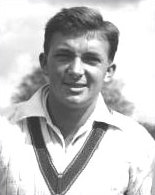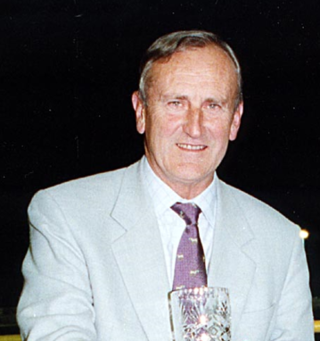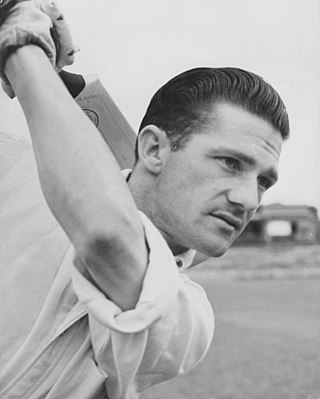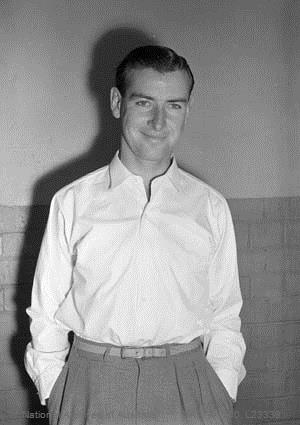Related Research Articles

Richard Benaud was an Australian cricketer who played for New South Wales and Australia. Following his retirement from international cricket in 1964,Benaud became a highly regarded commentator on the game.

Ian Michael Chappell is a former cricketer who played for South Australia and Australia. He captained Australia between 1971 and 1975 before taking a central role in the breakaway World Series Cricket organisation. Born into a cricketing family—his grandfather and brother also captained Australia—Chappell made a hesitant start to international cricket playing as a right-hand middle-order batsman and spin bowler. He found his niche when promoted to bat at number three. Known as "Chappelli",he earned a reputation as one of the greatest captains the game has seen. Chappell's blunt verbal manner led to a series of confrontations with opposition players and cricket administrators;the issue of sledging first arose during his tenure as captain,and he was a driving force behind the professionalisation of Australian cricket in the 1970s.
Gregory Stephen Chappell is a former cricketer who represented Australia at international level in both Tests and One-Day Internationals (ODI). The second of three brothers to play Test cricket,Chappell was the pre-eminent Australian batsman of his time who allied elegant stroke making to fierce concentration. An exceptional all round player who bowled medium pace and,at his retirement,held the world record for the most catches in Test cricket,Chappell's career straddled two eras as the game moved toward a greater level of professionalism after the WSC schism.

Edward Ralph Dexter,was an England international cricketer.
Peter Barker Howard May was an English cricketer who played for Surrey County Cricket Club,Cambridge University and England. Already a cricketing prodigy during his school days,May played his entire cricket career as an amateur,and was regarded by many players and fans as England's finest batsman in the post-war era.

Geoffrey Robert Marsh is an Australian former cricketer,coach and selector. He played 50 Test matches and 117 One Day Internationals for Australia as an opening batsman. Marsh was a part of the Australian team that won their first world title during the 1987 Cricket World Cup. As the coach of Australia he was in charge when Australia won the 1999 Cricket World Cup in England. He later coached Zimbabwe (2001–2004) and Sri Lanka (2011–12).

Brian Charles Booth was an Australian cricketer who played in 29 Test matches between 1961 and 1966,and 93 first-class matches for New South Wales. He captained Australia in two Tests during the 1965–66 Ashes series while regular captain Bob Simpson was absent due to illness and injury. Booth was a graceful right-handed middle order batsman at No. 4 or 5,and occasionally bowled right arm medium pace or off spin. He had an inclination to use his feet to charge spin bowlers. Booth was known for his sportsmanship on the field and often invoked Christianity while discussing ethics and sport.

Robert Neil Harvey is an Australian former cricketer who was a member of the Australian cricket team between 1948 and 1963,playing in 79 Test matches. He was the vice-captain of the team from 1957 until his retirement. An attacking left-handed batsman,sharp fielder and occasional off-spin bowler,Harvey was the senior batsman in the Australian team for much of the 1950s and was regarded by Wisden as the finest fielder of his era. Upon his retirement,Harvey was the second-most prolific Test run-scorer and century-maker for Australia.
Robert John Inverarity is a former Australian cricketer who played six Test matches. A right-handed batsman and left-arm orthodox spin bowler in his playing career,Inverarity was also one of the enduring captains in the Australian Sheffield Shield during the late 1970s and early 1980s,captaining both Western Australia and South Australia.
Graham Douglas McKenzie –commonly known as "Garth",after the comic strip hero –is an Australian cricketer who played for Western Australia (1960–74),Leicestershire (1969–75),Transvaal (1979–80) and Australia (1961–71) and was a Wisden Cricketer of the Year in 1965. He succeeded Alan Davidson as Australia's premier fast bowler and was in turn succeeded by Dennis Lillee,playing with both at either end of his career. McKenzie was particularly noted for his muscular physique and ability to take wickets on good batting tracks. His father Eric McKenzie and uncle Douglas McKenzie played cricket for Western Australia. Garth was chosen for the Ashes tour of England in 1961 aged only 20. He made his debut in the Second Test at Lord's,where his 5/37 wrapped up the England innings to give Australia a 5-wicket victory.

Ian Meckiff is a former cricketer who represented Australia in 18 Test matches between 1957 and 1963. A left-arm fast bowler,he is best known for two matters that were unrelated to his skill as a player:he was the batsman run out by Joe Solomon in 1960,causing the first Tied Test in cricket history;and in December 1963,his career was sensationally ended when he was called for throwing in the First Test against South Africa by Australian umpire Col Egar. During the late 1950s and early 1960s,there had been a media frenzy about the perceived prevalence of illegal bowling actions in world cricket. The controversy and speculation that dogged Meckiff in the years preceding his final match caused sections of the cricket community to believe that he had been made a scapegoat by the Australian cricket authorities to prove their intent to stamp out throwing.
John Russell Watkins is a former Australian cricketer who played in one Test match in 1973.
Phillip Henry Carlson was an Australian cricketer who played in two Test matches and four One Day Internationals (ODIs) in 1979. He was an all-rounder who played for Queensland between 1969–70 and 1980–81. He played his two Test matches for Australia v England in the 1978–79 Ashes series and the four One Day Internationals against the same opponents. He was called up by Australia when most of their regular first-choice players were playing in World Series Cricket.
The 1961 Australian cricket tour of England began with a three-day match versus Worcestershire at the County Ground,New Road,Worcester on Saturday 29 April,play continuing on Monday 1 May and Tuesday 2 May. This match was rain-affected and ended in a draw. The tour ended at Trinity College Park,Dublin on 19 September when the Australians completed a 282 run victory in a two-day match versus Ireland.

The England cricket team toured Australia and New Zealand between October 1962 and March 1963 with a one-match stopover in Colombo,en route to Australia. The tour was organised by Marylebone Cricket Club (MCC) and,in all matches other than Tests,the team was called MCC. In Australia,the tour itinerary consisted of 15 first-class matches,including the five-match Test series against Australia in which The Ashes were at stake. It was the last England cricket tour of Australia where the team travelled by ship.
The 1958-59 Australians defeated the touring England team 4-0 in the 1958–59 Ashes series. They were seen by the English press as having little chance of winning the series against the powerful England touring team. They had only one recognised great player,Neil Harvey and had lost the fast bowling combination of Ray Lindwall and Keith Miller and the other veterans of Don Bradman's Invincible 1948 team. There were,however,signs of recovery to those who would see them and E.W. Swanton believed that on their home ground Australia would be a shade better than England. The best indication of the forthcoming series was the M.C.C. and Australian tours of South Africa in 1956-57 and 1957-58. South Africa had a strong team in the 1950s,stunning the cricketing world by drawing 2-2 in Australia in 1953-54,losing 3-2 in the closely fought 1955 series in England and fighting back from a 2-0 deficit to draw 2-2 with Peter May's England in 1956-57. In 1957-58 Ian Craig led a team labelled as the weakest to leave Australia to a 3-0 victory over the Springboks with Richie Benaud,Alan Davidson,Wally Grout,Ken Mackay,Colin McDonald,Jim Burke and Lindsay Kline all in fine form. Norm O'Neill was not taken on tour,but struck innings of 175 in three hours and 233 in four hours in successive games against Victoria and was regarded as the "New Bradman".
The England team were very unhappy with the umpiring of the 1958–59 Ashes series,in particular the questionable actions of some bowlers in the Australian team. The televising of Test cricket was in its infancy and the notion of Test umpires using slow-motion replays or other modern techniques was considered absurd. Instead the umpires had to make judgements based on what they saw in a split-second,and honest mistakes were accepted as part and parcel of the game. However,touring teams sometimes felt that there was a natural bias towards the home team which led to some acrimony. Keith Miller thought "Mel McInnes,Colin Hoy and Ron Wright were our leading umpires in the 1954-55 M.C.C. tour of Australia,and I have no hesitation in saying that McInnes gave the finest exhibition of umpiring in a Test series that I have experienced". The England team thought well of him too,but in 1958-59 he lost the confidence of the England players and himself,appeared hesitant and gave some surprising decisions. In the Fourth Test he hesitated to give Ken Mackay out even after the batsman walked after snicking a catch off Brian Statham. Later Colin McDonald should have been run out when Fred Trueman flattened the stumps after his runner Jim Burke ran round the back of McInnes. McInnes gave him out,but then changed his mind and gave him not out as he had not seen whether Burke had made the run or not. On his next ball McDonald sportingly pulled his bat out of the way of the stumps to give Trueman "the easiest Test wicket I have ever taken". Trueman was affected again when he batted,given out caught by Wally Grout off Richie Benaud when he had dropped his bat and missed the ball. The England team became dispirited by the umpiring mistakes and,believing the officials to be against them,lost heart. As Fred Trueman wrote
...the Australian umpires demonstrated as much impartiality as a religious zealot. We just couldn't get favourable decisions and they no-balled England bowlers left,right and centre...one of the umpires consistently no-balled me...It was annoying,especially as this umpire seemed to allow Gordon Rorke to bowl with both his feet over the front line!...I suffered,as did others,from appalling umpiring decisions when batting...It was unbelievable."
The 1954–55 Australians lost 3–1 to the touring England team in the 1954–55 Ashes series. The Australian teams of the 1940s and early 1950s were strong even after the retirement of Don Bradman as many of his great 1948 side remained. Australia had lost only one series since 1932–33,when they lost he Ashes to Len Hutton in the exceptionally close fought 1953 Ashes series,but had played no Test cricket since. They had thrashed John Goddard's West Indian team 4–1 in 1951–52 after his triumphant 3–1 win in England,but had surprisingly been held to a 2–2 series draw against Jack Cheetham's South Africans in 1952–53. The general opinion in Australia was that they would win the return series,especially after the great victory in the First Test. "Although Australian batting was unsound by the old standards the presence of more all-rounders gave them the slightly better chance" wrote E.W. Swanton "all-rounders are said to hold the key to Test matches. Australia had four or five to England's one..."
Mark Lindsay Clews is a former Australian sportsman who represented New South Wales in cricket and the Australian Capital Territory in rugby union during the 1970s.